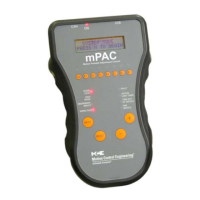Controller Installation
2-7
2
Motion 4000
Controller Wiring Guidelines
Detailed instructions for connecting the Motion 4000 controller and accompanying compo-
nents are contained in the drawings package for the job. During the job survey, site-specific
information collected is used to engineer the drawings package. Contact Motion Control Engi-
neering immediately if you have questions about the drawings or need additional assistance.
Be aware of the hierarchy of the inspection inputs. (Cartop has highest priority. In-car is next.
Machine Room is last.) In order to maintain safe operation of the lift while on access, car top, or
in-car inspection, the inspection circuits must be wired as shown in the prints.
PC boards can be easily damaged by Electrostatic Discharge (ESD). Use a properly
grounded wrist strap when touching PC boards. Do not touch PC Boards unless you are
properly grounded.
• Use the wiring ducts in the controller. The terminals are located conveniently near them.
• Connect wires according to hoistway and car wiring diagrams.
• If the car is part of a duplex or group, there are additional steps related to wiring intercon-
nects between individual cars:
• A separate conduit or wiring trough must be provided for the CAN link between each
controller cabinet.
• Wiring details are shown in the job prints.
• Ground all cabinets according to applicable guidelines. Please refer to “Proper
Ground” on page 2-7.
Proper Ground
Provide equipment grounding in accordance with local code and NEC Article 250. A proper
ground is essential to trouble free operation. Ground is defined as a direct connection to
EARTH GROUND. This type of ground is not always available in the electrical supply panel.
Electrical conduit is not a sufficient ground. Electrical ground should be obtained and certified
by the electrical contractor. When seeking an adequate EARTH GROUND:
• Consult with the building engineer or electrical contractor to determine the best source for
a low impedance ground.
• Sprinkler system water pipe is not adequate because the sprinkler system is, in most cases,
isolated from a free flowing earth water source.
If a poor ground connection is used and a true electrical ground is later introduced into the
system, the difference in potential can lead to the possibility of severe electrical shock to
personnel and damage to test equipment.

